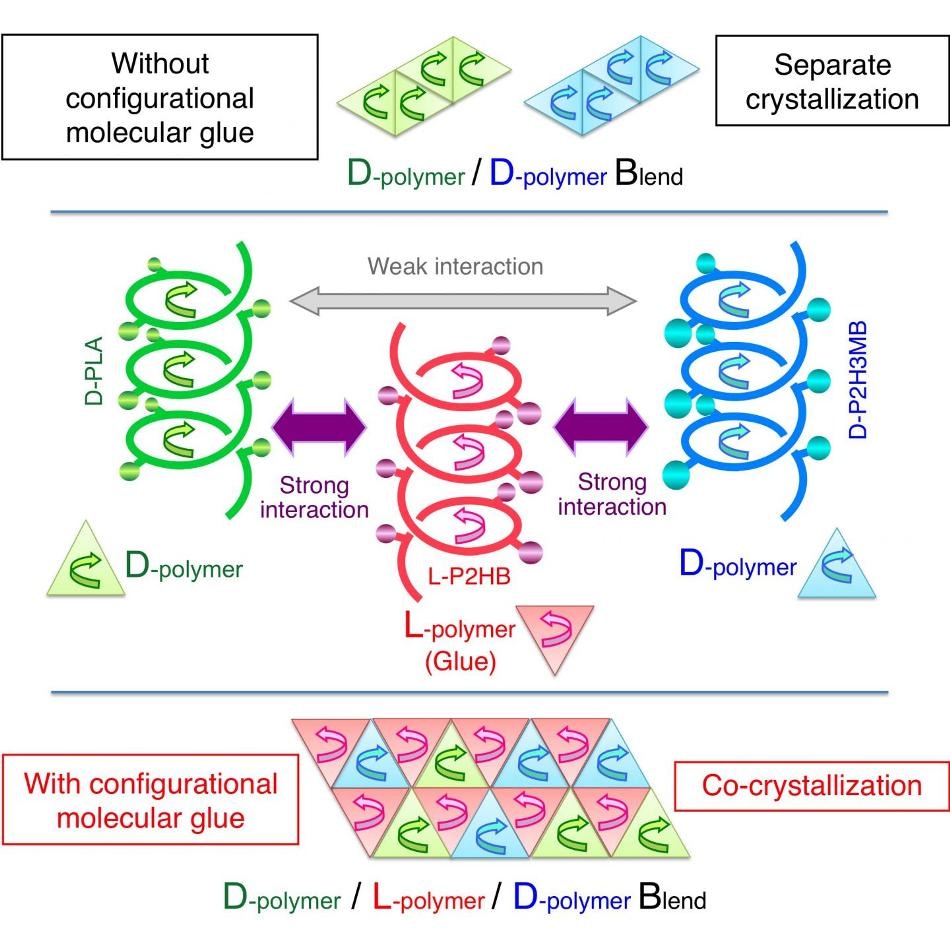Apr 11 2017
 This image shows helical molecular glue. (credit - Tsuji, H. et al. Configurational Molecular Glue: One Optically Active Polymer Attracts Two Oppositely Configured Optically Active Polymers. Sci. Rep. 7, 45170; doi: 10.1038/srep45170 (2017).
This image shows helical molecular glue. (credit - Tsuji, H. et al. Configurational Molecular Glue: One Optically Active Polymer Attracts Two Oppositely Configured Optically Active Polymers. Sci. Rep. 7, 45170; doi: 10.1038/srep45170 (2017).
A research team headed by Professor Hideto Tsuji carries out basic and applied research works on biodegradable polymers obtained from renewable resources such as potato or corn starch.
Poly(lactic acid), a typical biodegradable polymer, is the main focus of the study carried out by the research group. In the human body, hydrolysis and degradation of poly(lactic acid) and subsequent metabolization of the resulting lactic acid take place without any harmful effects to the body. This advantage makes poly(lactic acid) to serve as a scaffold material for tissue regeneration in medical applications. Poly(lactic acid) also holds potential for use in environmental applications.
Poly(lactic acid) consists of an asymmetric carbon, thus occurring either as the L-enantiomer (poly(L-lactic acid)) or D-enantiomer (poly(D-lactic acid)). The interaction is stronger between different enantiomers (i.e. between D and L) when compared to that between the same enantiomers (for example, between D and D). Therefore, co-crystallization of a D-enantiomer and an L-enantiomer occurs when two enantiomers are blended, and this phenomenon is known as stereocomplex formation.
The stereocomplex exhibits superior mechanical properties, better hydrolysis and heat resistance, and higher melting point when compared to its constituent enantiomers. Hence, compared to traditional biodegradable materials, the stereocomplex is a potential candidate material for a broader range of applications. Under such situations, stereocomplex formation between poly(lactic acid) has become the subject of intense research in recent years.
D-poly(lactic acid) is clockwise-helical and L-poly(lactic acid) is counterclockwise-helical. Hence, a stereocomplex formation from L-poly(lactic acid) and D-poly(lactic acid) signifies a strong attraction between a clockwise-helical molecule and a counterclockwise-helical molecule.
Tsuji et al. have also revealed the formation of a stereocomplex upon blending of the L- and D-enantiomers of poly(2-hydroxybutanoic acid) – a poly(lactic acid) consisting of an ethyl group in place of a methyl group. Moreover, study results have reported the occurrence of the same phenomena for poly(2-hydroxy-3-methylbutanoic acid) – a poly(lactic acid) consisting of an isopropyl group in place of a methyl group, as well as between poly(lactic acid) with different side chains (for instance, between D-poly(2-hydroxybutanoic acid and L-poly(lactic acid)). All these results signify that a clockwise-helical molecule and a counterclockwise-helical molecule have a strong interaction between them.
Now, Tsuji et al. have discovered the action of a counterclockwise-helical molecule to bind two clockwise-helical molecules that are structurally different and do not attach to each other otherwise.
Using D-poly(lactic acid), D-poly(2-hydroxy-3-methylbutanoic acid), and L-poly(2-hydroxybutanoic acid), Tsuji et al. have found for the first time that counterclockwise-helical L-poly(2-hydroxybutanoic acid) serves as "helical molecular glue" to glue clockwise-helical D-poly(2-hydroxy-3-methylbutanoic acid) and clockwise-helical D-poly(lactic acid) and as a result, these two D-molecules are co-crystallized, which does not occur otherwise.
This discovery has paved the way for binding different polymers that are coiled in the same direction. This increase in the degree of freedom in polymer combination has made it possible to develop new polymer materials with different properties.